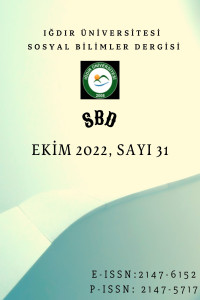Öz
Ekonomik kaynaklar ile doğal denge arasında doğrudan bir ilişki söz konusudur. Nitekim doğa yasaları, doğadaki canlı ve cansız varlıkların davranış ve hareketlerine yön veren bir süreç olarak temel belirleyici bir rol oynamaktadır. Adam Smith'e göre ekonominin işleyişi ve genel denge durumunun oluşması tamamen "görünmez el" olarak adlandırılan rasyonel insan davranışı sayesinde gerçekleşir. Demek ki doğa insanları kendi çıkarlarını gözeterek toplumsal çıkarlara hizmet etmeye yönlendiren bir içgüdüyle donatmıştır. Smith'in bu yaklaşımı Keynes tarafından da kabul edilmektedir. Keynes'e göre bireyler tüketim ve diğer ekonomik kararları “spiritus animalis” yaklaşımı çerçevesinde tıpkı göçmen kuşlar gibi içgüdülerine göre hareket ederek en doğru kararı vermeye çalışırlar. Smith ve Keynes'in bu yaklaşımları, matematikte altın oran ve buna dayalı Fibonacci yaklaşımlarının ekonomik göstergeler arasındaki ilişkiler açısından da değerlendirilebileceğini göstermektedir. Bu çalışmada altın oranı ile makroekonomik göstergeler arasında karşılıklı ve uyumlu bir ilişki olduğu tezi çerçevesinde bir analiz yapılmaya çalışılmıştır. Bu çerçevede altın oran teorisi makro ekonomik bir bakış açısıyla değerlendirilmiştir. Böylece ekonomi disiplininin diğer disiplinlerle nasıl bir mantıksal ilişki içinde olduğu gösterilmiştir.
Anahtar Kelimeler
Kaynakça
- Markowsky, G. (1992). Misconceptions about the golden ratio. The College Mathematics Journal, 23(1), 2-19.
- Prokopakis, E. P., Vlastos, I. M., Picavet, V. A., Nolst Trenite, G., Thomas, R., Cingi, C., & Hellings, P. W. (2013). The golden ratio in facial symmetry. Rhinology, 51(1), 18-21.
Öz
There is a direct relationship between the economic resources and the natural balance. Indeed, the laws of nature play a fundamental determining role as a process that directs the behavior and movements of living and non-living beings in nature. According to Adam Smith, the functioning of the economy and the formation of the general state of equilibrium occur entirely thanks to the rational human behavior called the "invisible hand". It means nature has equipped people with an instinct that directs them to serve the social interest while considering their own concerns. This approach of Smith is also accepted by Keynes. According to Keynes, while individuals make consumption and other economic decisions with the “spiritus animalis”, they try to make the best decision by acting according to their instincts, just like migratory birds. These approaches of Smith and Keynes show that the golden ratio in mathematics and the Fibonacci approaches based on it can also be evaluated in terms of the relations between economic indicators. In this study, an analysis has been tried to be made within the framework of the thesis that there is a mutual and harmonious relationship between macroeconomic indicators and the golden ratio of a country.In this context, the golden ratio theory has been evaluated from a macroeconomic perspective. Thus, it has been shown how the discipline of economics is in a logical relationship with other disciplines
Anahtar Kelimeler
Fibonacci Financial Analysis Golden Ratio Macroeconomic Indicators
Kaynakça
- Markowsky, G. (1992). Misconceptions about the golden ratio. The College Mathematics Journal, 23(1), 2-19.
- Prokopakis, E. P., Vlastos, I. M., Picavet, V. A., Nolst Trenite, G., Thomas, R., Cingi, C., & Hellings, P. W. (2013). The golden ratio in facial symmetry. Rhinology, 51(1), 18-21.
Ayrıntılar
| Birincil Dil | İngilizce |
|---|---|
| Bölüm | Araştırma Makalesi |
| Yazarlar | |
| Yayımlanma Tarihi | 29 Ekim 2022 |
| Yayımlandığı Sayı | Yıl 2022 Sayı: 31 |


